Texas, with its sprawling landscapes and varied ecosystems, is home to a wide array of hawk species. These magnificent raptors, celebrated for their aerial agility and hunting prowess, contribute to the rich biodiversity of the Lone Star State. Whether you are a seasoned birder or a casual wildlife enthusiast, exploring the hawks of Texas offers a captivating encounter with these remarkable birds of prey.
Types of Hawk in Texas
Red-tailed Hawks: Commonly seen soaring over open areas throughout the state, including in the scenic landscapes of Hill Country.
Harris’s Hawks: These social raptors can be often seen in the desert areas of South Texas, including Big Bend National Park.
Swainson’s Hawks: Known for their migration in large numbers, they frequent the agricultural fields of the Panhandle.
Red-shouldered Hawks: They thrive in the forested areas and can be seen along the rivers in the Piney Woods region of East Texas.
Cooper’s Hawks: A common sight in woodlands and suburban areas, they can be seen in places like the Houston Arboretum & Nature Center.
White-tailed Hawks: These hawks prefer coastal grasslands and can be seen in abundance at Padre Island National Seashore.
Northern Harrier: Regularly sighted in wetlands and prairies like the Anahuac National Wildlife Refuge in Southeast Texas.
Sharp-shinned Hawk: Often spotted in dense forests, they can be seen in East Texas, particularly around the Sabine National Forest.
Broad-winged Hawks: A common sight during the spring and fall migrations, particularly in the forests of the Lost Pines region near Bastrop.
Zone-tailed Hawks: A typical resident of the hilly regions, they can often be spotted around the Guadalupe River State Park.
Gray Hawks: Seen primarily in the Lower Rio Grande Valley, they can be spotted in locations like the Santa Ana National Wildlife Refuge.
Ferruginous Hawks: Preferring open plains, they are visitors to the Panhandle region during the winter.
Northern Goshawks: While quite rare in Texas, there have been occasional sightings in the forested regions of the Davis Mountains.
Rough-legged Hawks: Though a rare visitor, they have been sighted in the Panhandle region during the winter months.
Common Black Hawks: A scarce sight, but a few have been spotted in riparian areas in the Trans-Pecos region, particularly near Big Bend National Park.
The crane hawk and roadside hawk, native to central America is sometimes also spotted in Southern Texas.
Texas Hawks Photo Guide
Red-tailed Hawk (Buteo jamaicensis)

The Red-tailed Hawk is a large bird of prey that is commonly found across North America. This species is part of the genus Buteo, which is often referred to as the “true hawks,” and includes more than two dozen species of raptors.
Red-tailed Hawks have a robust size, ranging from 18 to 26 inches in length and sporting a wingspan that can exceed 4 feet. They have a broad, rounded set of wings and a short, wide red tail. This species is most easily recognized by its rich, rust-colored tail, which gives it its common name. However, juvenile hawks might not yet have this distinctive feature.
Their feathers are generally dark brown on their dorsal side (back) with a lighter, often speckled, ventral side (front). The intensity and pattern of their plumage can vary significantly based on their age and geographic location, as there are about 14 recognized subspecies of Red-tailed Hawks.
As for their diet, Red-tailed Hawks are carnivores and have a broad diet that includes rodents, ground rabbits, reptiles, and other birds. They are skilled hunters that typically sit on high perches and use their keen eyesight to spot potential prey. Once they have identified a target, they swoop down to capture it with their powerful talons.
Red-tailed Hawks mate for life and build nests high off the ground, often in tall trees or on cliff edges. Their nests are made of sticks and can be quite large. They typically lay 1-3 eggs per year, which are incubated by both parents.
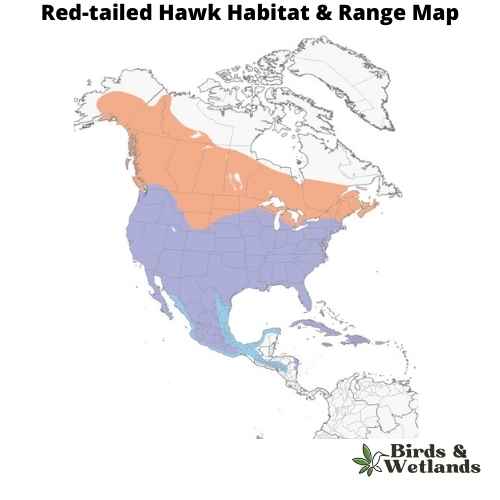
Red-tailed Hawk Sound
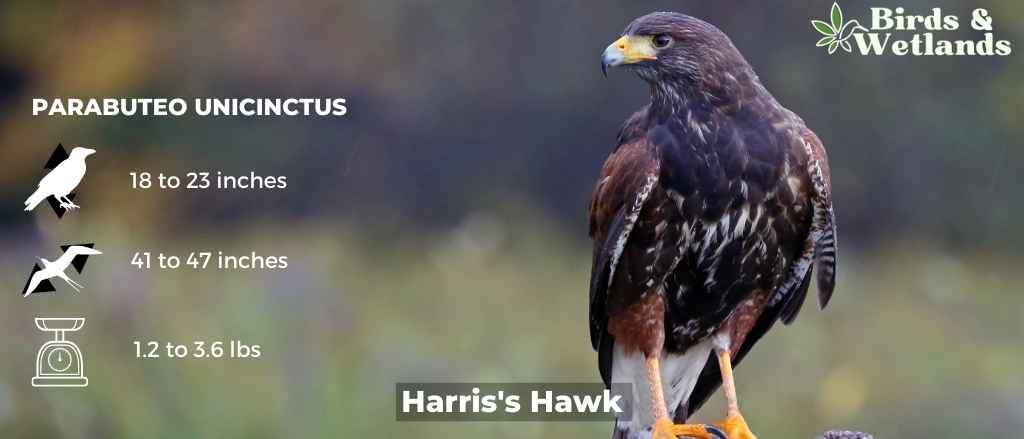
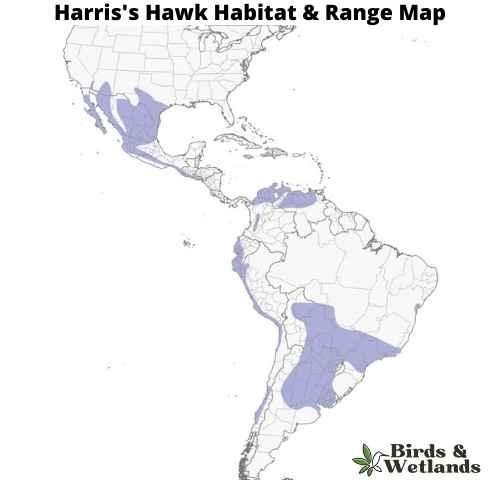
Harris’s Hawk Sound
Scientific Name: Parabuteo unicinctus
Length: 18 to 23 in
Wingspan: 41 to 47 in
Weight: 1.2 to 3.6 lb
The Harris’s Hawk is a unique bird of prey, recognized by its distinct social behavior and richly colored plumage. This raptor prefers semi-arid habitats like desert scrub, woodlands, and savannas.
Harris’s Hawk sports a dark brown or chestnut-brown body, with striking reddish-brown shoulders and legs. A characteristic feature of this bird is its white-tipped tail, along with a white band on the underside of its tail feathers.
Harris’s Hawks diet mainly consists of small mammals, birds, and lizards. One of the unique behavioral traits of this species is that it often hunts cooperatively in groups, a rarity among raptors. This group hunting strategy often involves surrounding and flushing out prey, or taking turns chasing it, which increases the likelihood of a successful hunt. Harris’s Hawk also engage in “stacking,” where they perch on top of each other, which is a behavior rarely seen in birds of prey.
Nesting for Harris’s Hawks involves the building of a platform of sticks in a tree or cactus, where the female usually lays 2 to 4 eggs. Both parents share in the incubation and rearing of the chicks, with sometimes even older offspring assisting in the process.
Swainson’s Hawk (Buteo swainsoni)
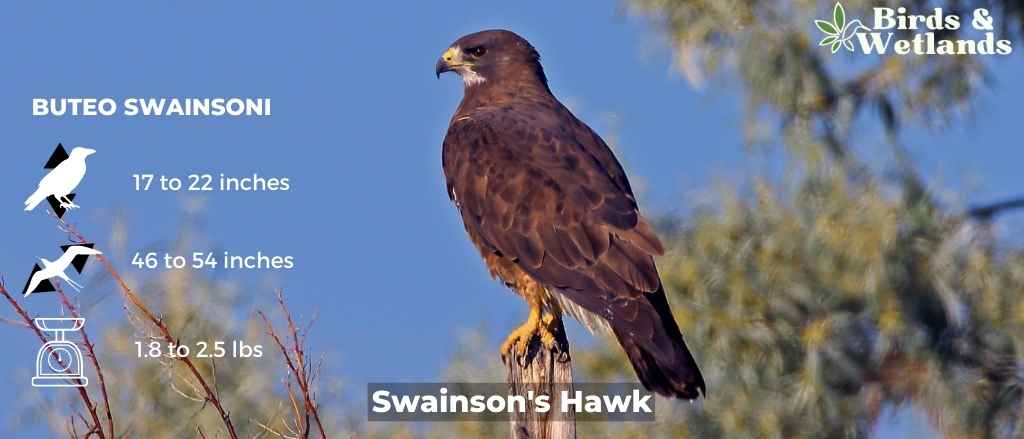
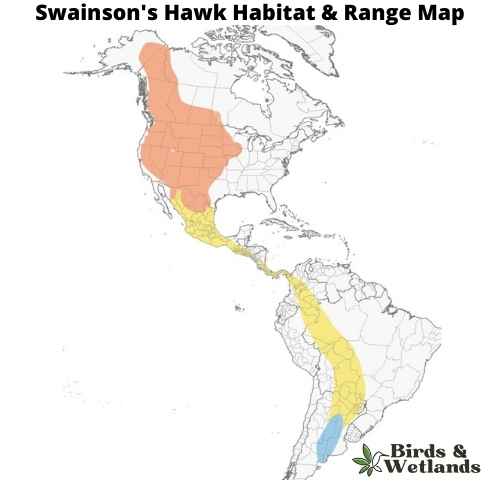
Listen: Swainson’s Hawk
Swainson’s Hawk is a medium-sized hawk that is found in North America and South America, Scientific Name: Buteo swainsoni.
The bird has a blue-gray plumage with a dark brown back, wings, and tail. It also has a white chest and belly. The beak and feet are black, but the eyes are yellow. They are often confused with Cooper’s Hawk because of similar coloring, but Swainson’s Hawks have wider tails and longer wings than their cousin species.
These birds eat small rodents such as gophers and mice. They also eat insects like grasshoppers and crickets during the summer months when they’re plentiful. They sometimes steal prey from other birds of prey such as Northern Harriers who hunt the same prey.
Swainson’s Hawks build nests on rocky cliffs near water sources where they can find food easily. They lay three to five eggs that hatch after about two months into fluffy brown baby hawks who leave the nest after about three weeks (or when they’re big enough).
Red-shouldered Hawk (Buteo lineatus)

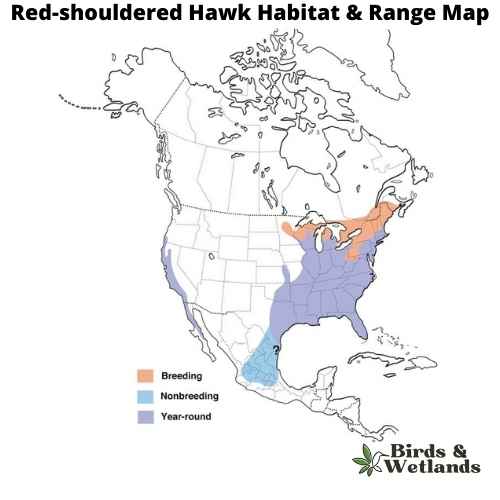
Listen:
The red-shouldered hawk are medium sized birds of prey, part of the buteo hawks family. It can be distinguished from other hawks by its reddish iris and pale legs.
The adult has rusty red upperparts, white underparts, a black chin and throat, and a reddish brown stripe over each eye, reddish brown heads and a strongly banded tail. The tail is reddish brown with two paler bands across it and they have white checkered wings. Juveniles are brown with dark barring and have pale fringes on the feathers of their wings.
Red-shouldered hawks nest in trees, though they also inhabit manmade structures including barns, bridges, and buildings. They prefer wooded areas with an open canopy but will use other places as well for nesting such as shrubs and hedges if needed.
The red-shouldered hawk’s diet – they eat small mammals such as ground squirrels, rabbits, voles, mice and rats. They also eat birds such as quail, pigeons and doves; reptiles including snakes; amphibians; fish; crustaceans; insects; and carrion (dead animals).
Cooper’s Hawk (Accipiter cooperii)

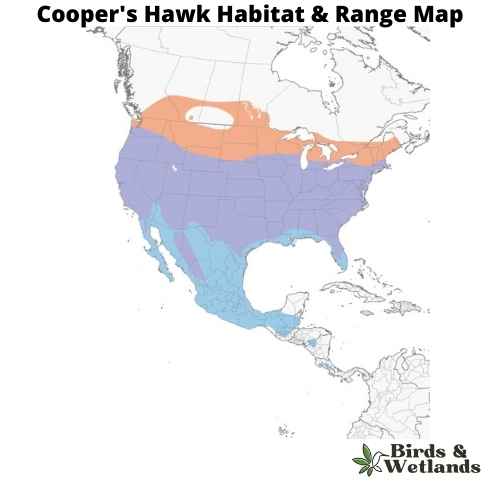
Listen:
The Cooper’s Hawk is a medium-sized bird of prey native to North America. Known for its agility and speed, it is part of the Accipitridae hawk species, which also includes other hawks, eagles, and kites.
Cooper’s Hawks are typically about 14 to 20 inches in length, with a wingspan ranging from 27 to 36 inches. They are known for their distinctive long, rounded tails and short, rounded wings. They have a steely blue gray top, with rusty bars on their underparts and thick, dark bands on their tails.
The Cooper’s Hawk is a skilled predator, primarily hunting birds and small mammals. They are adept at hunting in both dense forests and open areas, often catching prey mid-air in high-speed pursuits. They have also been known to visit the backyard bird feeder, not for the seed, but to prey on the smaller birds that gather there.
Cooper’s Hawks often build nests in dense tree canopies where they are well concealed. The female usually lays 3 to 5 eggs, and both parents share incubation duties. The young hawks fledge after about a month but will stay close to the nest, relying on their parents for food as they learn to hunt.
White-tailed Hawk (Geranoaetus albicaudatus)

The white-tailed hawk is a medium-sized bird of prey found in North America. It is one of the most common hawks on the continent, and it is often seen soaring high above the ground on its long wings.
- Scientific Name: Geranoaetus albicaudatus
- Length: 44–60 cm (17–24 in)
- Wingspan: 118–143 cm (46–56 in)
- Weight: 880–1,240 g (1.94–2.73 lb)
White-tailed Hawk Description
The white-tailed hawk has a large body and broad wings, with a tail that is mostly white with black bars. The head is grayish-brown, and there are white streaks above the eyes. The breast is grayish, while the belly is brownish-gray. The feathers on the back are dark brown with pale edges. The underwing coverts are white with brown tips. The white-tailed hawk has a black bill and brown legs. The eyes are yellow or orange with red orbital rings.
White-tailed Hawk Sound
White-tailed Hawk Habitat & Range
White-tailed hawks live in open country, including fields, deserts, grasslands, and even mountains. They like flat areas to hunt from so they can see their prey from far away. It can be found as far north as Canada and as far south as Mexico.

White-tailed Hawk Diet
White-tailed hawks eat small animals like mice, rats, rabbits, squirrels, birds (including chickens), reptiles (like snakes), amphibians (like frogs or toads), insects like grasshoppers and beetles as well as carrion (dead animals) such as road-killed deer or raccoons.
White-tailed Hawk Nesting
The White-tailed Hawk nests in tree cavities or on the ground, depending on the location. The female lays two eggs at a time and incubates them while the male hunts for food. After about two months, the eggs hatch and both parents take turns feeding their young until they are old enough to leave the nest on their own.
Northern Harrier (Circus hudsonius)

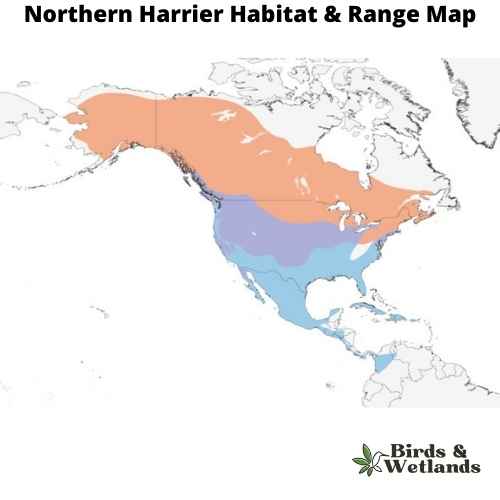
Listen:
The Northern Harrier is a medium-sized, slender hawk.
Adult birds are gray above, with pale bars on the wing feathers and white markings on the underwings and a white rump patch. The breast is barred with black and white, and the belly is streaked with brown.
They prefer open areas, such as grasslands and marshes, but can be found in almost any open habitat except dense woods.
Northern Harriers are opportunistic hunters that feed on small mammals such as mice, voles and rabbits as well as birds including quail, grouse and ducks. They hunt by flying low over open spaces such as fields or marshes.
Northern harrier nests on the ground in lowlands or hillsides near water bodies. It lays two to four eggs which hatch after 24 days of incubation by both parents. The chicks fledge after 30 days of hatching and remain dependent on their parents for another three weeks during which they learn how to fly.
Sharp-shinned Hawk (Accipiter striatus)

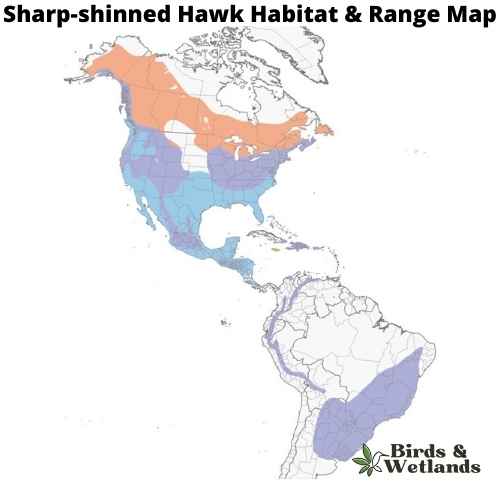
Listen:
The adult bird is brown on top and white underneath, with a dark brown band across its chest. It has short, rounded wings and a long tail that makes it look larger than it actually is. Adult sharp shinned hawks have black eyes, which are surrounded by white feathers. The female Sharp-shinned Hawk is browner than the male, who has darker brown markings on his back.
Sharp-shinned Hawks prefer open country for their habitat, including fields and meadows where they can hunt for mice and other small animals. They can be found throughout the United States but are most common in the east.
Sharp-shinned Hawks eat mostly small birds, such as sparrows and warblers, as well as small mammals such as mice and gophers. They catch prey by surprise using their incredible speed and agility, diving out of the sky at speeds up to 200 mph.
Sharp-shinned Hawks have an unusual hunting style for hawks—they prefer to catch their prey from perches above trees or telephone wires, rather than swooping down from above like most other hawks do and can often be seen hunting near bird feeders.
Broad-winged Hawk (Buteo platypterus)

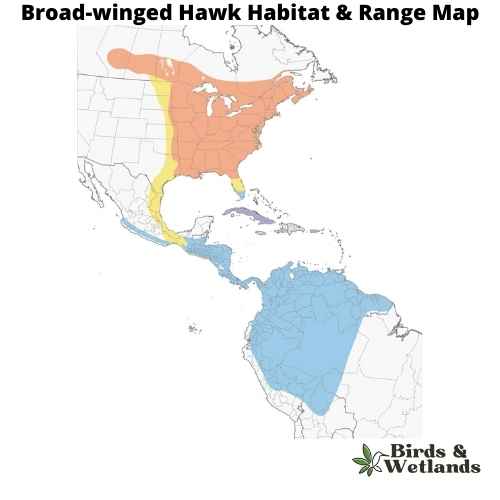
Broad-winged Hawk Sound
The Broad-winged Hawk holds a commanding presence as one of the largest hawks in the world, known for its broad wings. Its formidable size is a testament to its prowess as a bird of prey, effortlessly navigating the open skies in search of food.
Their distinctive appearance sets them apart. The adults exhibit a striking black and white pattern, complemented by a rusty breast and buff underparts and brown wings. In contrast, juveniles are adorned with a brown plumage, marked by pale edges on their feathers, adding to their distinctive youthful charm.
These hawks are most commonly found in open areas, such as farmlands or grasslands interspersed with scattered trees, which provide optimal conditions for when hawks hunt.
When it comes to their diet, Broad-winged Hawks feed on small rodents like mice, rats, squirrels, rabbits, and voles. Broad winged hawks breed during the spring and summer months then migrate to central and south America.
Zone-tailed Hawk (Buteo albonotatus)
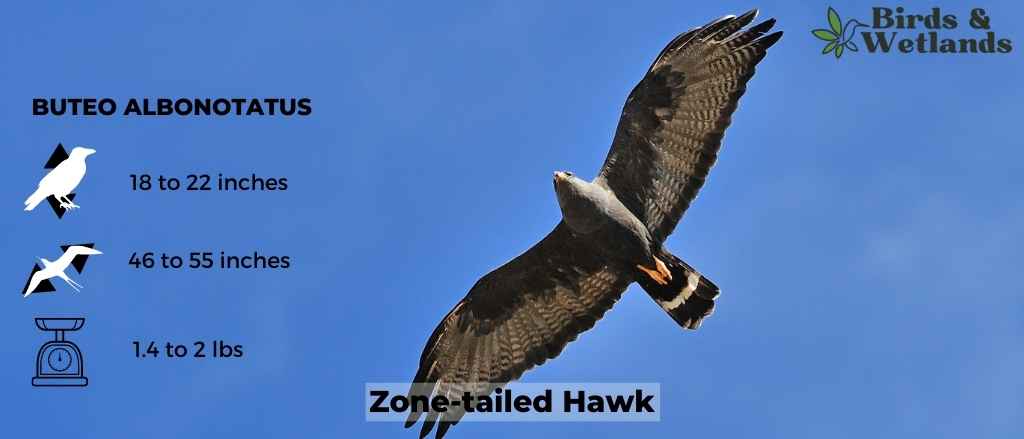

Zone-tailed Hawk Sound
Scientific Name: Buteo albonotatus
Length: 18 to 22 in
Wingspan: 46 to 55 in
Weight: 1.2 to 2 lb
The Zone-tailed Hawk, or Buteo albonotatus, is a medium-sized bird of prey known for its unique appearance and behavior that mimics turkey vultures, a strategy used to deceive prey. This raptor is primarily found in the warmer regions of the Americas, including the southwestern United States, Mexico, and down to Argentina.
The Zone-tailed Hawks body are predominantly black, with white bands, or “zones,” on the tail, which give the bird its name. From a distance, the Zone-tailed Hawk can easily be mistaken for a turkey vulture due to its similar coloration and flight pattern.
Zone-tailed Hawk feeds on small mammals, birds, and reptiles. Its hunting strategy is particularly clever. By mimicking the less-threatening turkey vulture in flight, it can often approach prey unnoticed before launching a surprise attack.
Nesting typically takes place in trees, cliffs, or even on man-made structures. The female lays 1 to 3 eggs, and both parents share incubation and feeding duties.
Gray Hawk (Buteo plagiatus)

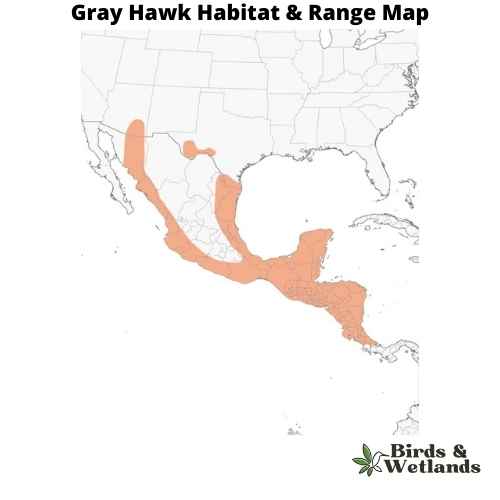
Gray Hawk Sound
Scientific Name: Buteo plagiatus
Length: 18–24 in
Wingspan: 82-98 cm
Weight: 16.8 oz
The Gray Hawk is a small bird of prey native to the Americas. Known for its distinct coloration and elegant flight, this raptor is found in both the southwestern United States and across Central and South America.
Gray Hawks plumage is characterized by a light gray body, contrasted with a darker gray back and wings. Its tail features broad white and gray bands, making it a distinctive feature.
Primarily hunting from a perch, the Gray Hawk feeds mainly on small mammals, birds, and reptiles, including lizards and snakes. It often patrols the edges of clearings, diving swiftly to catch prey off guard.
Nesting for the Gray Hawk typically occurs in trees. The female usually lays 1 to 3 eggs, and both parents share in incubation duties. The nestlings are generally dependent on the parents for food for a few weeks after hatching.
The Gray Hawk’s call is a high-pitched, plaintive scream, which is often repeated several times. The species is primarily a solitary bird, usually seen alone or in pairs.
Ferruginous Hawk (Buteo regalis)

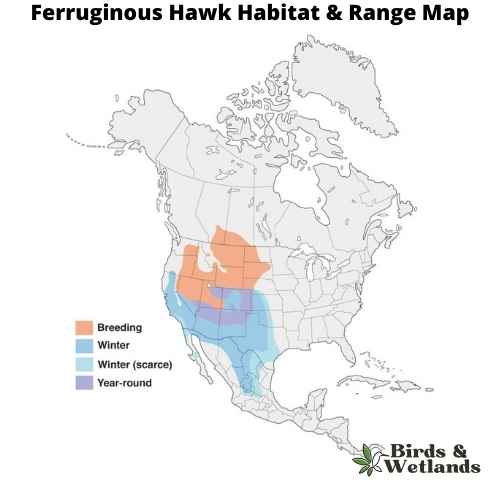
Ferruginous Hawk Sound
Scientific Name: Buteo regalis
Length: 20 to 27 in
Wingspan: 48 to 60 in
Weight: 32.0 to 80.0 oz
The Ferruginous Hawkis the largest hawk species native to North America. Known for its distinctive coloration and impressive size, this bird of prey predominantly inhabits the open landscapes of the western United States and parts of Canada.
Ferruginous Hawks are notable for their “ferruginous” or rust-colored back and shoulders, which contrasts sharply with the bird’s white underside. The hawk also has broad, rounded wings and a large, gape-mouthed beak. Ferruginous hawks exhibit dark morph and light morphs. Dark morphs have dark brown plumage, while light morphs display lighter, reddish-brown plumage. Morphs vary geographically.
Primarily feeding on small to medium sized mammals like rabbits and prairie dogs, the Ferruginous Hawk is an agile hunter, often seen soaring high above the ground or perched prominently while scanning for prey. It occasionally feeds on birds, reptiles, and insects as well.
Nesting for Ferruginous Hawks typically occurs on cliffs, hillsides, or large trees. The female lays between 2 to 5 eggs, and both parents share in the incubation and rearing of the chicks. The Ferruginous Hawk is a relatively solitary bird outside of the breeding season, and its call is a loud, high-pitched scream, often heard during courtship or near the nest.
Northern Goshawk (Accipiter gentilis)


Listen:
The Northern Goshawk is a medium-sized hawk that is found in North America, Europe and Asia. It has brown eyes, a large sharp beak, and dark brown plumage on its upperparts and head, with white underparts that are spotted with brown barring. Its tail feathers are grayish-black with a dark band near the tip.
Northern goshawks eat squirrels, rabbits, grouse, woodchucks and other small mammals like voles or mice (which they often eat whole). They will also take larger prey such as deer fawns or even adult deer if they have no other choice. They have broad wings with long feathers that allow them to glide through the air when they catch their prey. They also have an excellent sense of smell which helps them locate their food source.
The Northern Goshawk builds its nest in a tree cavity or on a ledge, usually on the edge of an open area so it can easily see prey below. The female lays 3 to 5 eggs over two days and incubates them for 28 to 30 days while the male brings food to her every few hours until they hatch. The young fledge after about 6 weeks and leave the nest when they are about 10 weeks old.
Rough-legged Hawk (Buteo lagopus)

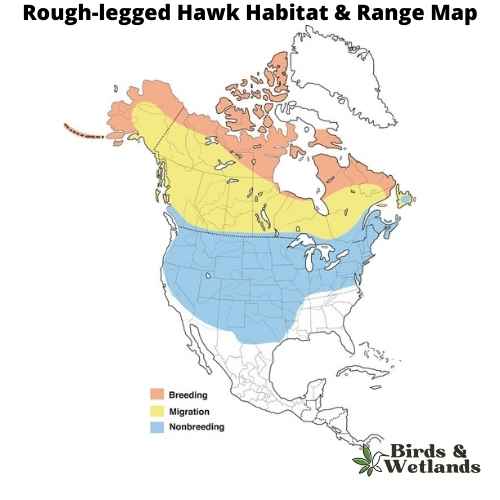
Rough-legged Hawk Sound
The Rough-legged Hawk is a large, raptor that is native to North America. It is also known as the American Rough-legged Hawk. Scientific Name: Buteo lagopus
The Rough-legged Hawk is a medium-sized hawk with a distinctive appearance, with dark brown feathers on its back and light brown feathers on its underside and broad thin wings. The hawk’s legs are also covered in dark feathers, which help to distinguish it from other species of hawk. The tail is barred with black and white. They have yellow eyes and dark feet.
Rough-legged Hawks hunt from above ground level, swooping down to catch its prey in its talons. When hunting for food, they prefer to eat small mammals such as squirrels and rabbits but will also eat birds if there aren’t any small mammals available. Although they eat a variety of small animals including birds, rodents, bats and reptiles, they rely heavily on fish for food during breeding season because it provides them with protein and calcium needed to produce eggs.
Common Black Hawk (Buteogallus anthracinus)
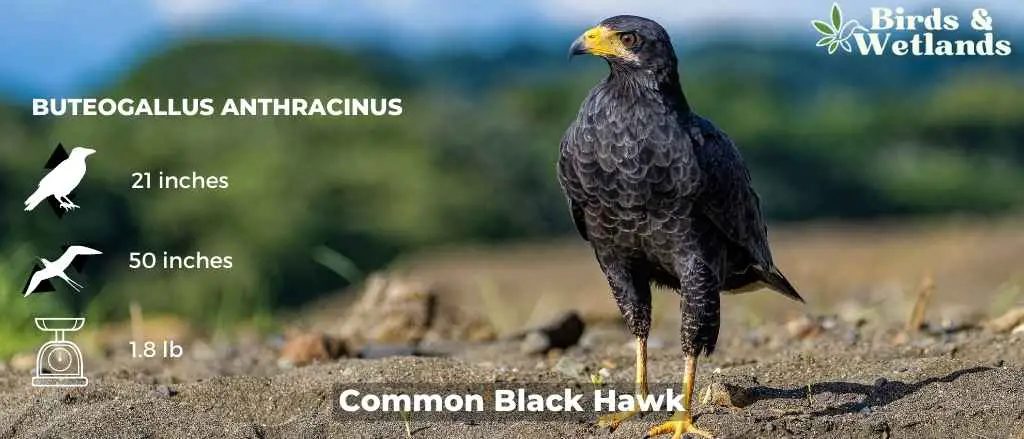
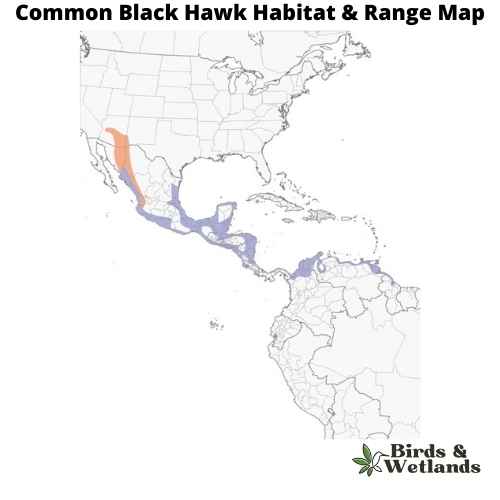
Common Black Hawk Sound
Scientific Name: Buteogallus anthracinus
Length: 21 in
Wingspan: 50 in
Weight: 840g
The black hawk has dark brown feathers on its back and chest, with white feathers on its belly and under its tail. The back feathers have white spots and bars that give it an overall speckled appearance. Its eyes are yellowish-brown, and its legs are long and pinkish-white in color with black talons at the end.
Common Black Hawks tend to live in open spaces near water sources like lakes or rivers because they need water for bathing and drinking as well as hunting prey animals that may be found near such areas.
Common Black Hawks prefer to hunt for small mammals like rabbits, squirrels, and rats. They also eat reptiles like snakes and lizards if they can find them.
Where to Spot Hawks in Texas
Big Bend National Park: Located in South Texas, this park is a prime spot to see Harris’s Hawks and Common Black Hawks due to its desert environment. The park’s unique ecological diversity attracts a wide variety of hawks throughout the year.
Padre Island National Seashore: This coastal area is known for its White-tailed Hawks. The seashore provides a rich habitat for hawks, thanks to its vast grasslands and coastal environment.
Anahuac National Wildlife Refuge: Located in Southeast Texas, this refuge is an excellent spot to observe Northern Harriers. Its extensive wetlands provide ideal hunting grounds for these hawks.
Lost Pines Region near Bastrop: Known as a migration hotspot, particularly for Broad-winged Hawks. The forested region offers a diverse habitat, attracting a wide variety of hawk species during the spring and fall migration periods.
Lower Rio Grande Valley: This area, particularly the Santa Ana National Wildlife Refuge, is a notable spot for observing Gray Hawks. The riparian woodlands of the valley create a unique habitat for this species.
Exploring Texas provides an exciting opportunity for hawk-watchers, given the state’s diverse landscapes and abundance of raptors. Yet, extending your birdwatching journey beyond Texas into its neighboring states offers equally enriching experiences. Each bordering state presents unique environments, leading to a range of hawk species that can vary greatly from those found in Texas.
| Neighbouring State’s Hawks | Hawk Watching Site |
|---|---|
| Hawk Species in Oklahoma | Black Mesa Nature Preserve |
| Hawk Species in Arkansas | Mount Magazine State Park |
| Hawk Species in Louisiana | Red River National Wildlife Refuge |
| Hawk Species in New Mexico | Sandia Crest Hawk Watch Site |


